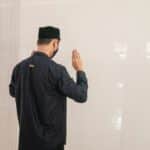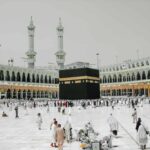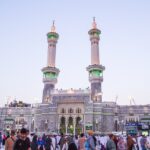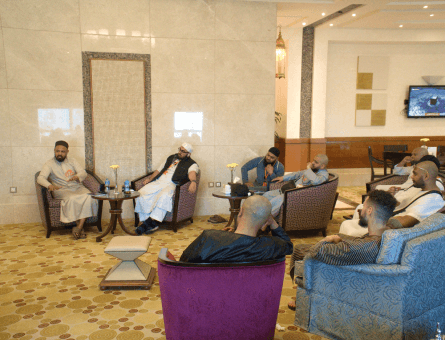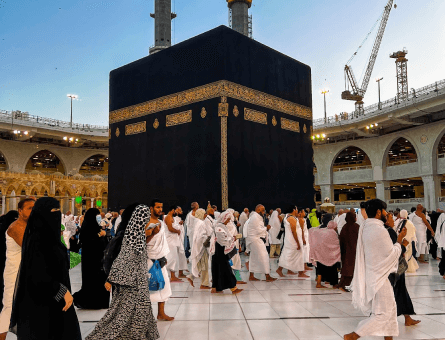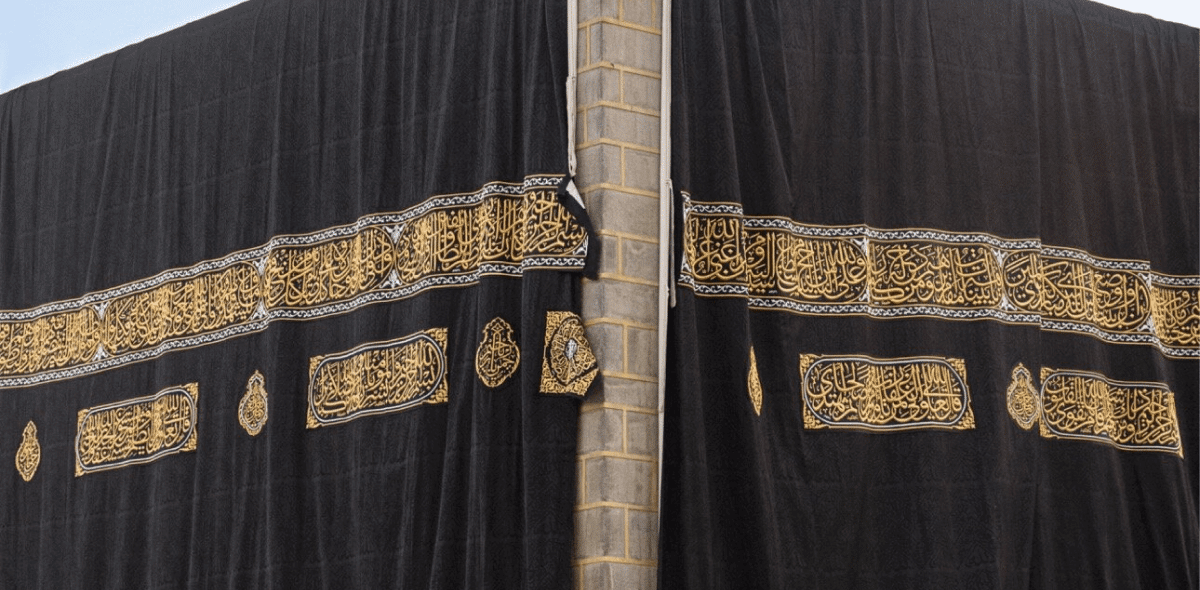Kiswah – The cloth that covers the Kaaba
Inside Masjid Al Haram (the Great Mosque of Makkah, Saudi Arabia), a unique and pleasant scent begins to rise as you approach the Holy Kaaba, a scent you might not expect. The smell is of a heady and thick perfume that gets stronger as you reach the House of Allah SWT. This aroma originates from the ornate silk clothing covering the Holy Kaaba also known as the Kiswah.
The doors of the Kaaba open twice a year; 30 days before Hajj and 30 days before Ramadan. However, the Kiswah is annually replaced on the 9th of Dhul Hajj; the day pilgrims visit Mount Arafat.
Here is everything you need to know about Kiswah and its significance in Islam.
What Is the Kiswah?
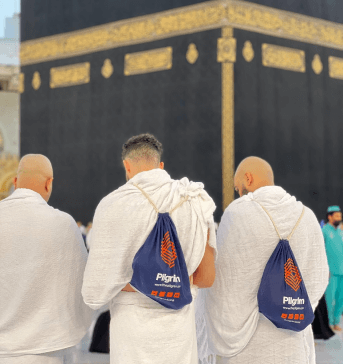 Otherwise known as the “Ghilaf,” the word “Kiswah” literally means robe. Changed on the 9th of Dhul Hajj, woven from cotton and silk and adorned with the verses of the Holy Quran, the Kiswah is a black coloured cloth that covers the Holy Kaaba. The Kiswah comprises a gold band of ornamental calligraphy of the Quranic verses.
Otherwise known as the “Ghilaf,” the word “Kiswah” literally means robe. Changed on the 9th of Dhul Hajj, woven from cotton and silk and adorned with the verses of the Holy Quran, the Kiswah is a black coloured cloth that covers the Holy Kaaba. The Kiswah comprises a gold band of ornamental calligraphy of the Quranic verses.
Every year, during the 5th pillar of Islam (Hajj), the Kiswah is replaced with a white cloth that represents the Ihram of the pilgrims.
By the end of the 9th Dhul Hajj, the temporary cover of the Holy Kaaba is replaced with a brand new Kiswah. Moreover, the new cover of the Holy Kaaba is affixed using copper rings to the stones located at the marble base. However, the old one is cut into small pieces and is sold out or gifted to pilgrims and influential religious (honourable Muslim) personalities from all around the world.
What Is Written on the Kaaba?
The cover of the Holy Kaaba (Kiswah) is aesthetically pleasing. However, most people wonder what the beautifully engraved Arabic calligraphy in the golden colour state. Every year, millions of Muslims from all over the world visit the Holy Kaaba for pilgrimage (Umrah or Hajj). Manufactured from 47 strips of clothing, every strip of the Kiswah is about 14cm long and 101cm in width.
Together there are three horizontal rows embedded on the black side of the cover of the Holy Kaaba. Each of the rows states the following:
First Row: Ya Allah is written with His two names. “Ya Hannan,” which means “Merciful towards servants,” and “Ya Mannan,” which means “Tremendous in Giving.”
Second Row: “La Illaha Illa Allah Muhammad Ur Rasulullah” which means “There is no God except Allah and Muhammad PBUH is His last messenger.”
Third Row: “SubhanAllah hi Wabihamdi hi SubhanAllah hil Azeem,” which states that “Allah is free from any kind of imperfection, and all praise is for Allah. Allah is free from any kind of imperfection; Allah is the greatest.”
As stated earlier, most of the gold embroidery on the Kiswah is of relevant verses from the Holy Quran. The following verse is embedded on the side of the Kiswah from Rukan Yamani and Hajr al-Aswad:
“In the name of God, Most Gracious, Most Compassionate. That is so. And whoever honours the symbols of Allah, it is certainly out of the piety of the heart.” [Surah Hajj: 32]
The Kiswah throughout Time
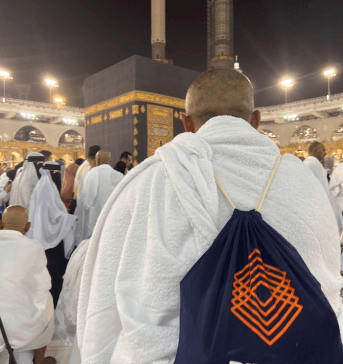 According to Islamic history, Prophet Ismail (AS) is said to be the first person to cover the Holy Kaaba. However, after the spread of Islam, providing the cloth for Kiswah became an honour for any ruler who wanted to claim authority over Makkah, Saudi Arabia. Here is how the colours and materials of the Kiswah have changed throughout time:
According to Islamic history, Prophet Ismail (AS) is said to be the first person to cover the Holy Kaaba. However, after the spread of Islam, providing the cloth for Kiswah became an honour for any ruler who wanted to claim authority over Makkah, Saudi Arabia. Here is how the colours and materials of the Kiswah have changed throughout time:
- The era of Prophet Muhammad (PBUH): The Kiswah was made from a red and white striped Yemeni cloth.
- Caliphate of Hazrat Abu Bakr (RA), Hazrat Umar (RA), and Hazrat Usman (RA): The Kiswah was manufactured from white coloured Egyptian cloth.
- The era of Abdullah bin Zubair (RA): A red brocade coloured Kiswah was used to cover the Holy Kaaba.
- The era of Seljuks: A golden-ish brown coloured Kiswah was used to cover the Holy Kaaba.
- The era of Abbasid Caliph Al-Nasir: Green coloured cloth was used to drape the Holy Kaaba.
- The era of Caliph Al-Nasir to Date: A Black silk cloth with golden embroidery is used as the Kiswah today. The pure silk cloth is imported from Italy.
The Kiswah during Prophet Muhammad’s (PBUH) Time
Before the conquest of Makkah, Prophet Muhammad (PBUH) and his companions weren’t allowed by the Quraysh leaders to cover the Holy Kaaba. Therefore, after Prophet Muhammad (PBUH) conquered the lands of Makkah, the old Kiswah was burned and replaced with a white and red striped Yemeni cloth.
However, during their Caliphate, Hazrat Abu Bakr (RA), Hazrat Umar (RA), and Hazrat Usman (RA) used a pure white Egyptian cloth named “qibati” to cover the Holy Kaaba.
Different Materials, Fabrics, and Colours Used to Cover the Kaaba
Based on the facts that we know, Kiswah is manufactured using approximately 650kg (47 pieces) of natural silk that is imported from Italy. Each silk piece is 98cm by 14 metres. The inside of the Kiswah is made from strong cotton lining in order to help preserve the silk top.
It also has a 95cm wide and 46 metres long belt section that is responsible to hold the Kiswah in place. This belt is made using 16 pieces of silk cloth and is embroidered with Quranic verses. Furthermore, approximately 120kg of silver and gold threads that come from Germany are used to emboss the Quranic verses on the Kiswah.
Sitara – the curtain of the Holy Kaaba is also included in the Kiswah. The curtain was placed on the gate of the Holy Kaaba for the first time in 819 Hijri. The Sitara is a representation of dedication and having true faith as several verses are embroidered using silver thread and gold plating.
How Much Does it Cost to Make the Kiswah for the Kaaba?
According to the current stats, it costs around £3.4m to make the Kiswah. Every year, over 200 craftsmen work together to manufacture the Kiswah. Whereas the task of embroidering the Quranic verses takes around 8 to 10 months approximately.
How Often Is the Kiswah Changed?
The Kiswah is changed once every year on the 9th of Dhul Hajj. The black cloth of the Holy Kaaba’s cover is usually made two months prior to Hajj and is handed over to the keeper of the Holy Kaaba, who belongs to the Bani Shaybah family of Makkah. The old Kiswah is then cut into pieces and is presented as a gift to dignitaries and a gift to Muslim countries.
Changing the Kiswah ensures that it will not come to a state of being worn down and will not structurally compromise the Kaaba if they were layered on top of one another
Manufactured in Saudi Arabia
Since 1927 the Kiswah Al Kaaba Factory has been responsible to manufacture the cover of the Holy Kaaba – Kiswah. It was established by King Abdul Aziz soon after he conquered the Hejazi region. Owned and managed by the Saudi Government, it takes the whole year to manufacture the cover of the Holy Kaaba and a further six to eight months to embroider it with the verses of the Holy Quran.
Kiswah Factory
The Kiswah factory was inaugurated in 1972 in Makkah, Saudi Arabia. It had about 200 employees, of which 114 solely worked on the embroidery of the Quranic verses on the Kiswah. The factory has now established a four-step process that is used to produce the Kiswah.
The manufacturer starts by importing raw silk from Italy, dyed over 22 hours, and is mechanically woven into black sheets. These sheets are then separated as some will be embroidered using silver and gold while the others will remain black. Following this, the black cloth of the Kiswah is tested for density and resistance by specialists, who then print the pattern of the embroidery over it.
The craftsman then used one of the world’s largest sewing machines, having a 16m by 14m sewing table, to sew together the 54 pieces of the Kiswah. During the embroidery step, the factory also manufactures a cotton lining to cover the inside of the Kiswah.
Note that two Kiswahs are produced every year; one is used to cover the Holy Kaaba while the other one is kept as backup.
After the previous Kiwah is removed it is cut into small pieces and offered to organisations, museums and dignataries.
Facts about the Kiswah
Do you think you know everything there is to know about the Kiswah? Read on to learn some amazing yet lesser-known about the sacred cover of the Holy Kaaba – Kiswah:
Fact 1: The Man Who Changes the Kiswah
Asad Al Himari was a Yemen resident and the first man ever to change the Kiswah, the cover of the Holy Kaaba. It is believed that in the old days of the Arabian Peninsula, leaders of different types were responsible for covering the Holy Kaaba using drapes and various types and colours of cloth.
Fact 2: The Colour of the Kiswah Wasn’t Always Black
The colour of the Holy Kaaba has evolved during the reigns of various rulers and Caliphs. The Kiswah used to be white during the life of Prophet Muhammad (PBUH). It was then changed to red, then green, and finally black as of today.
Fact 3: Over the Years, Many Countries Have Been the Provider of the Cloth of Kiswah
Mohd. Ali Pasha, an Egyptian Viceroy, had created the manufacturing process of the Kiswah. After splitting from the Turkish Empire, Mohd. Ali Pasha made it his responsibility to make sure that the task was successful every year. Little do people know that the unique cloth used to make the cover of the Holy Kiswa usually comes from Baghdad, Yemen, Iraq, and Egypt. However, today, silk cloth is imported from Italy, whereas the silver and gold threads are bought from Germany.
Summary – Kiswah
Five times a day, Muslims worldwide face the Holy Kaaba, which was built by Prophet Ibrahim (AS). They pray while turned towards it, pray Salah, and yearn to visit it at least once during their lives. The covering of the Holy Kaaba is known as the Kiswah, and it is changed annually during the days of Dhul Hajj. Even today, many Muslims wish to own pieces of the Kiswah as it is considered sacred
Explore The New Pilgrim App
The Ultimate App
for Hajj and Umrah!





